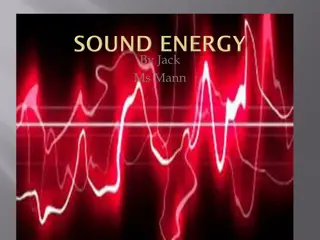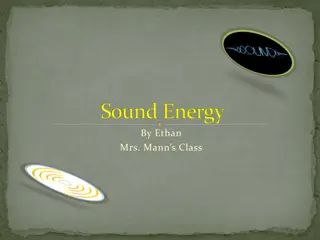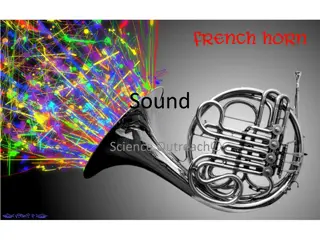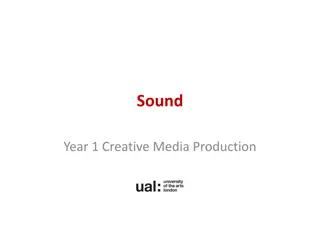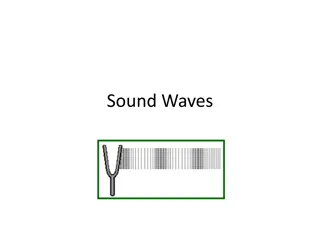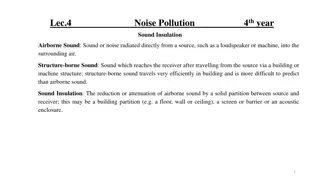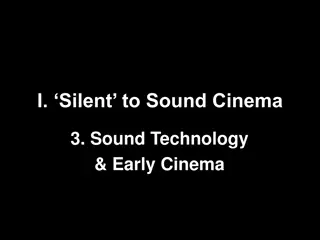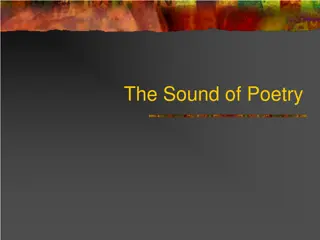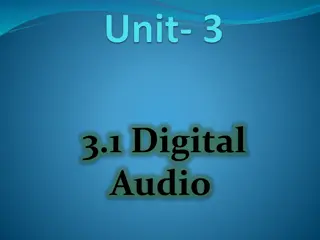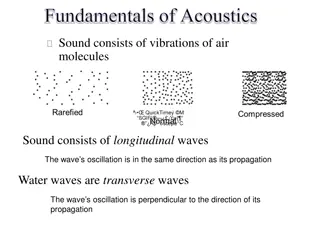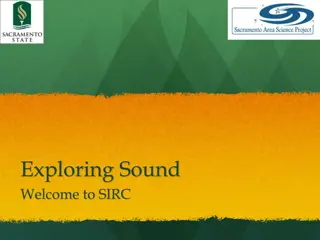Understanding Sound: Energy, Pitch, Transmission, and Speed
Sound is a form of energy that travels through a medium by vibrations. It carries intensity and pitch, with frequency determining pitch. Sound requires a medium to travel, unlike light. Elasticity and temperature of the medium affect the speed of sound transmission. Understanding how sound waves propagate through different mediums is crucial to comprehend the nature of sound.
Download Presentation

Please find below an Image/Link to download the presentation.
The content on the website is provided AS IS for your information and personal use only. It may not be sold, licensed, or shared on other websites without obtaining consent from the author. Download presentation by click this link. If you encounter any issues during the download, it is possible that the publisher has removed the file from their server.
E N D
Presentation Transcript
WHAT IS SOUND? A form of energy that travels through the air.
WHAT IS SOUND? Sound is made when something vibrates. Sound needs a medium to travel. The loudness of a sound is called volume.
Intensity:The amount of energy that flows through a certain area in a specific amount of time Louder sound waves carry more energy Intensity decreases as distance increases.
WHAT IS PITCH? The pitch of a sound is how high or low it is. A sound with a high frequency has a high pitch. Frequency is the number of vibrations per second.
HOW IS SOUND TRANSMITTED? Transmission of sound requires matter (air, liquids, solids) as transmitting medium, unlike light which can travel through matter and space.
HOW SOUND TRAVELS Sound waves carry energy through a medium without moving particles of the medium along Each particle of the medium vibrates as the disturbance passes. When the disturbance passes your ear you hear the sound A common medium for sound is air, but sound can travel through many other mediums
Speed of Sound: Elasticity The more elastic the medium, the faster sound travels Sound travels well in solids because they are usually more elastic Particles of solids do not move very far , so they bounce back and forth very quickly as the compressions and rarefaction of the sound waves pass Most liquids are not very elastic and sound does not travel well Sound travels very slowly in gases because gases are not very elastic
Speed of Sound: Temperature Sound travels more slowly at lower temperatures than at higher temperatures This is because at low temperatures, the particles of the medium move more slowly At low temperatures the particles are harder to move and return to their original positions more slowly. Example: @ 20 C 343 m/s @ 0 C 330 m/s
HOW DO WE USE SOUND? For human beings, sound is one of the most important ways to communicate by: expressing himself through speech obtaining information through listening obtaining stimulation (music)
WHAT IS SOUND? The tools of information exchange through sound are: Throat: vocal cords for producing and modulating speech sounds Ear: for listening and analyzing sounds
HOW DO YOU MAKE SOUND? You force air up through your voice box, or larynx Your larynx consists of two folds of tissue called vocal chords (like guitar strings)








